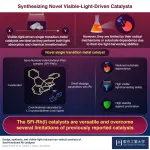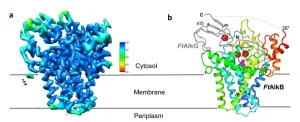(Press-News.org) On bright chilly mornings you can either snuggle down under the duvet or leap up and seize the day.
However, for photosynthesising plants, this kind of dawn spells danger, so they have evolved their own way of making cold mornings tolerable.
Research led by the John Innes Centre has discovered a cold “coping” mechanism that is under the control of the plant biological clock and could offer solutions to breeding more resilience into crops less suited to cold climates.
“We’ve identified a new process that helps plants tolerate cold. It’s controlled by the biological clock of plants, and we think it could be especially important on cold, bright mornings,” says Professor Antony Dodd, a group leader at the John Innes Centre.
“Crops such as winter wheat and winter oilseed rape experience cold temperatures for periods of their cultivation,” he continues. “We think that the mechanism that we have discovered could provide greater resilience of photosynthesis to cold temperatures. It represents an interesting target for future precision breeding of climate resilient crops.”
Cold temperatures can damage plant cells, particularly when combined with too much light or during freezing temperatures. Hence why those bright cold mornings are so dangerous to plants.
The researchers wanted to know how information about low temperatures is communicated to the chloroplasts, the site of photosynthesis inside a plant cell, essential for all our major crops.
Chloroplasts contain their own small genome that reflects their evolutionary past as photosynthetic bacteria, before they were engulfed and co-opted by plants to carry out photosynthesis. Throughout evolution many genes from the chloroplast transferred to the plant nuclear genome, but chloroplasts have held on to some essential genes.
In this research the team focussed on one such bacterial genetic legacy called a sigma factor (SIG5). In bacteria, comparable sigma factors contribute to responses to temperature.
In experiments conducted under controlled laboratory conditions they manipulated the light conditions, and subjected plants to periods of chilling.
Removing plants from the day night cycle enables researchers to better study the free-running rhythms of the plant biological or circadian clock. In plants, as in humans, the clock is aligned to the 24-hour cycle, offering a measure of time inside cells, and regulating a range of essential biological processes.
The experiments showed sensitivity of the SIG5 gene to cold treatment early in the morning, under the control of the circadian clock.
The team theorise that SIG5 operates as part of a signalling network that links the plant nucleus to the chloroplasts, regulating activities that can protect the plant against harmful environmental effects.
“If the temperature is cold then some enzymes involved in photosynthesis break down quickly.” explains Professor Dodd. “So, we think the process that is controlled by the nucleus signals into the chloroplast to make more of these proteins. When the plant sees cold and light at the same time, they need to switch on this signalling process from nucleus to chloroplasts to make more of these photosynthesis proteins.”
The role of the biological clock is to act like a gate that either lets the signal through or not, a process known as circadian gating.
“Plants could have evolved to be particularly responsive to it being light and cold, like a spring morning, because these are the conditions that damage the photosynthetic system. At some point during evolution, they have selected for this sensitivity and co-opted this ancient mechanism. Like many such processes in plants, this one turns out to be under the control of the circadian clock.”
The mechanism has been shown to work in the lab. The next stage of this research is to understand the impact of this process in the field. One intriguing application is to see if the mechanism can be modified to further increase cold tolerance, for example to grow plants that are less tolerant of cold, such as maize, at more northern latitudes.
The research is a collaboration between the John Innes Centre, the University of Bristol, Tokyo Institute of Technology and Nippon Telegraph and Telephone Corporation in Japan, and Durham University.
Low-temperature and circadian signals are integrated by the sigma factor SIG5, appears in Nature Plants.
END
How plants cope with the cold light of day - and why it matters for future crops
2023-03-30
ELSE PRESS RELEASES FROM THIS DATE:
WPI-led team uncovers new details of SARS-COV-2 structure
2023-03-30
Worcester, Mass. – March 30, 2023 – A new study led by Worcester Polytechnic Institute (WPI) brings into sharper focus the structural details of the COVID-19 virus, revealing an elliptical shape that “breathes,” or changes shape, as it moves in the body. The discovery, which could lead to new antiviral therapies for the disease and quicker development of vaccines, is featured in the April edition of the peer-reviewed Cell Press structural biology journal Structure.
“This is critical knowledge we need to fight future pandemics,” said Dmitry Korkin, Harold L. Jurist ’61 and Heather E. Jurist Dean’s ...
University Hospitals research published in New England Journal of Medicine shows minimally invasive procedure saves most patients with severe vascular disease from amputation
2023-03-30
CLEVELAND – A study published in the March 30 issue of the New England Journal of Medicine has shown that there may finally be an alternative to amputation for patients suffering from chronic limb-threatening ischemia (CLTI), the most severe form of peripheral artery disease. This study, co-led by University Hospitals (UH) Harrington Heart & Vascular Institute, could lead to the first FDA approval of a therapy giving thousands of patients hope for an alternative to limb loss.
THERAPY SAVES MOST PATIENTS FROM AMPUTATION
The PROMISE II U.S. pivotal clinical trial found that minimally ...
Columbia establishes the Center for the Transition to Parenthood with funding from the Bezos Family Foundation
2023-03-30
NEW YORK, NY (March 30, 2023)--With a transformational gift from the Bezos Family Foundation, Columbia will launch the Center for the Transition to Parenthood (TtP) in the Department of Obstetrics and Gynecology (Ob/Gyn). Supported by the most advanced scientific knowledge in the field, the TtP Center seeks to reinvent prenatal care, address the mental health of parents, improve the overall health of their infants, and promote family well-being.
The Center, established with a gift of $21 million from the Bezos Family Foundation, will develop, test, and put into practice a range ...
Form is (mal)function: Protein’s shape lets bacteria disarm it
2023-03-30
Shigella bacteria can infect humans but not mice. In the March 29 issue of Nature, a team from UConn Health explains why. Their findings may explain the multifariousness of a key weapon of our immune system.
Shigella infections cause fever, stomach pain, and prolonged, sometimes bloody diarrhea for as long as a week. The bacteria sicken 450,000 people each year in the US alone. Although most people recover on their own, children and those with weakened immune systems are at risk of Shigella ...
Thermal paint — MXene spray coating can harness infrared radiation for heating or cooling
2023-03-30
An international team of researchers, led by Drexel University, has found that a thin coating of MXene — a type of two-dimensional nanomaterial discovered and studied at Drexel for more than a decade — could enhance a material’s ability to trap or shed heat. The discovery, which is tied to MXene’s ability to regulate the passage of ambient infrared radiation, could lead to advances in thermal clothing, heating elements and new materials for radiative heating and cooling.
The group, including materials science ...
An improved, visible light-harvesting catalyst to speed up reactions
2023-03-30
Photocatalysis is the use of light to accelerate the rate of a reaction in the presence of a photocatalyst. The catalyst plays a crucial role in this process—it absorbs the light being shined onto it and makes it available in way that can help accelerate the chemical reaction and also enhance it. These catalysts are used for a variety of light-dependent reactions ranging from the production of paper to the conversion of carbon dioxide to fuel. Given these applications, the development of ideal photocatalysts is important. An ideal ...
Structure of 'oil-eating' enzyme opens door to bioengineered catalysts
2023-03-30
UPTON, NY—Scientists at the U.S. Department of Energy’s Brookhaven National Laboratory have produced the first atomic-level structure of an enzyme that selectively cuts carbon-hydrogen bonds—the first and most challenging step in turning simple hydrocarbons into more useful chemicals. As described in a paper just published in Nature Structural & Molecular Biology, the detailed atomic level “blueprint” suggests ways to engineer the enzyme to produce desired products.
“We want to create a ...
Allies or enemies of cancer: the dual fate of neutrophils
2023-03-30
Why do cancer immunotherapies work so extraordinarily well in a minority of patients, but fail in so many others? By analysing the role of neutrophils, immune cells whose presence usually signals treatment failure, scientists from the University of Geneva (UNIGE), from Harvard Medical School, and from Ludwig Cancer Center have discovered that there is not just one type of neutrophils, but several. Depending on certain markers on their surface, these cells can either promote the growth of tumours, or fight them and ensure the success of a treatment. By boosting the appropriate factors, neutrophils could become great agents of anti-tumour ...
Shining light on the mechanics of embryo development
2023-03-30
Summary
Scientists have come up with a new method to study the mechanical properties of developing embryos with unprecedented speed
The new method – line-scanning Brillouin microscopy (LSBM) – relies on a microscopy technique based on Brillouin scattering – a phenomenon where light interacts with naturally occurring thermal vibrations within materials.
The method, which can be used to non-invasively study developing embryos in three dimensions and across time, was selected as one of The Guardian's ...
Buprenorphine initiation in the ER found safe and effective for individuals with opioid use disorder who use fentanyl
2023-03-30
Buprenorphine initiation in the ER found safe and effective for individuals with opioid use disorder who use fentanyl
With historically high overdose death rates in U.S., multi-site NIH study reinforces importance of continued, uninterrupted access to addiction medication
Results from a multi-site clinical trial supported by the National Institutes of Health showed that less than 1% of people with opioid use disorder whose drug use includes fentanyl experienced withdrawal when starting buprenorphine in the ...








